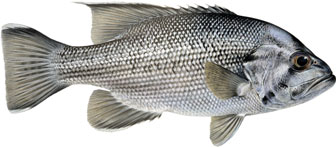
The West Australian dhufish (Glaucosoma hebraicum) is a Western Australian (WA) fishing icon. It grows to a great size, tastes superb and is targeted by both recreational and commercial fishers. This species belongs to the Glaucosomatidae family (the pearl perches). It’s endemic to WA, which means it doesn’t occur anywhere else.
The dhufish is an inshore demersal fish, which means it lives close to shore and close to the seabed.
Dhufish is an indicator species for the inshore demersal ‘suite’ (group) of species in the West Coast Bioregion (from east of Augusta to north of Kalbarri). The stock status of dhufish is used to indicate the status of all inshore demersals in the region. As such, dhufish plays an important part in the sustainable management of our fisheries.
Distribution and habitat
Dhufish occur between Shark Bay and the Recherche Archipelago near Esperance. They are most common along WA’s lower west coast between Kalbarri and Augusta.
Adult dhufish can usually be found on reefs 20 to 50 m deep, however, sometimes they have surprised fishers by turning up in water just 3 m deep.
Juveniles of less than 150 mm in length are rarely caught by fishers or divers, but research has revealed they often occur in sandy habitats at similar depths to adults. Young fish of about 150-300 mm then move to low-lying reefs, while adults prefer reefs with large rocky outcrops and ledges.
Tagging studies have shown dhufish are generally sedentary – they usually don’t travel far from home. This is supported by studies of the chemical elements that occur in dhufish earbones (otoliths), which record ‘signatures’ of the environment they have lived in.
Lifecycle
As with many demersal species, dhufish live a long time - they can reach more than 40 years of age. Individuals can grow to more than a metre in length and weigh more than 25 kg. Dhufish are relatively slow-growing, and like most fish species, grow most quickly when young. Their growth slows down considerably after about 12 years, but it can take 20 years before they reach their maximum size.
Dhufish reach sexual maturity on average at three years old, when females are 300 mm long and males are 320 mm long.
Spawning (release of sperm and eggs) occurs from November to April with a peak period in January and February when water temperatures are elevated. Spawning appears to take place over isolated reef outcrops and weed-covered sandy areas.
Older and larger females release more eggs, more often and for a longer period than younger females. This means big female dhufish produce more eggs per spawning season, making them very important for the overall health of dhufish stocks.
Dhufish eggs and larvae are dispersed by currents, contributing to the high level of variation in dhufish recruitment (addition of young fish to the overall fish population) to different parts of the coast.
Water temperature and the availability of food are among other factors that may affect spawning and survival of dhufish eggs, larvae and juveniles.
Diet
Dhufish have big eyes used to seek food at night and their cavernous mouths allow them to ambush their prey. Dhufish eat other fish, crustaceans and molluscs, such as squid and octopus.
Illustration © R. Swainston/www.anima.net.au